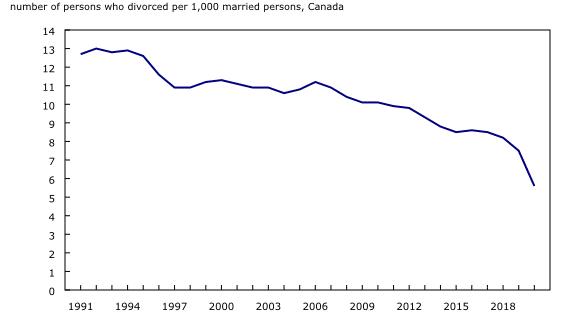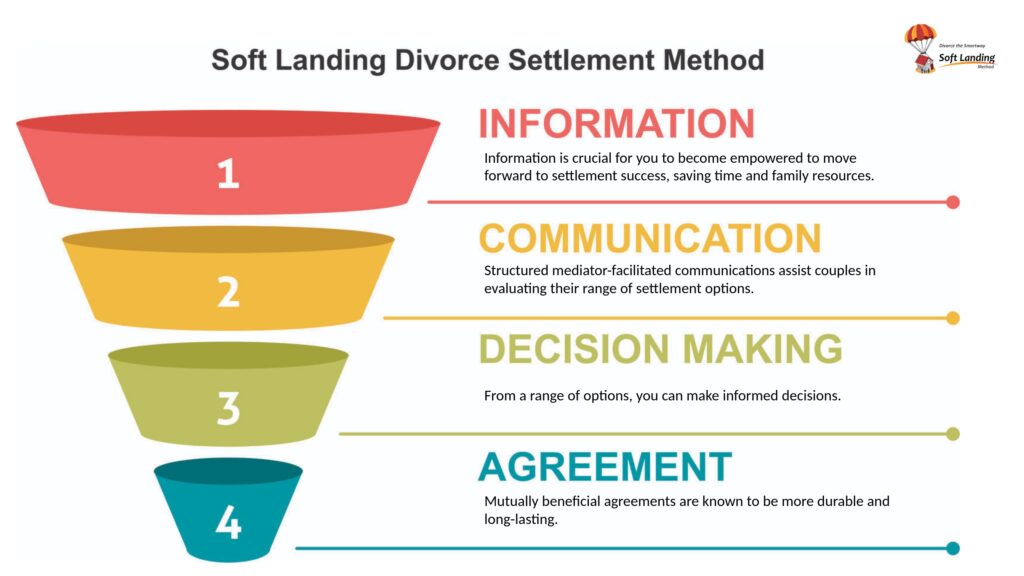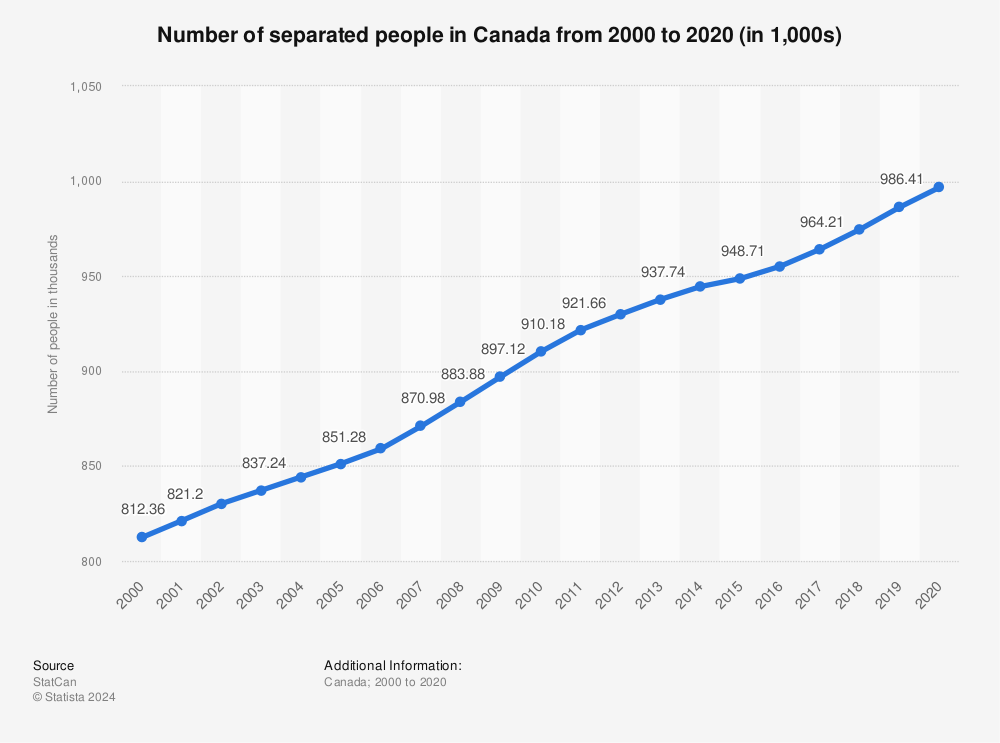When the Statistics of Divorce in Canada Apply to You -DTSW can help

Understanding the Canadian divorce rates is crucial for individuals, families, and policymakers, as it offers insights into the patterns and elements contributing to the causes of divorce in Canada.
In this piece, we will delve into the present state of divorce rates in Canada, discuss regional differences, and scrutinize the factors influencing these rates. The introduction of no-fault divorce laws significantly impacted divorce rates, not only in Canada but globally. Consequently, it’s a subject widely researched by sociologists, economists, and legal scholars. Understanding its effects can offer valuable insights into the dynamics of marriage and divorce.
What is the Divorce Rate in Canada: A Close Examination
In the years following the introduction of no-fault divorce laws, many jurisdictions, including Canada, saw a notable increase in divorce rates. We can attribute this surge to several factors.
However, with the advent of no-fault divorce, couples could part ways due to irreconcilable differences or after living separately for at least one year, thereby making divorce more attainable.
Furthermore, the no-fault divorce act lessened the societal stigma surrounding divorce. Consequently, as societal perceptions of divorce evolved, more individuals felt at ease with the idea of filing jointly for divorce when their marriages were no longer fulfilling.
Get Acquainted Call
Do you want a Soft Landing?
Have a few questions?
Learn More:
Schedule a 15-Minute Complimentary Call
What Percentage Of Marriages End In Divorce In Canada
As of 2021, Canada’s divorce rate stands at approximately 38%. This statistic implies that 38% of marriages will culminate in divorce before reaching the 30-year mark. It’s crucial to highlight that divorce rates have remained fairly steady over the past decade, with a slight downward trend from the peak rates seen in the 80s and 90s.
Divorce Rates in Ontario and Regional Variations
The divorce rate in Canada exhibits significant variations across different provinces and territories. Cultural, economic, and social factors contribute to these regional disparities. For instance, Quebec records one of the highest divorce rates in the country, while Newfoundland and Labrador boast one of the lowest. These regional differences are important to consider when analyzing national divorce statistics.
How Common is Divorce in Canada
Several elements can impact the Canadian Divorce Rates including:
- Age at marriage: Younger adults who marry are more likely to divorce than those who marry later in life.
- Education: Higher education levels generally correlate with lower divorce rates.
- Income: Higher income levels often bring financial stability and are typically associated with lower divorce rates.
- Cohabitation: The risk of divorce may increase for couples who live together before marriage, although this relationship is multifaceted and depends on various factors.
- Children: While having children can stabilize marriages, it can also introduce stress that may lead to divorce.
- Religion: Religious beliefs and practices can influence divorce rates, with some religious groups recording lower rates than others.
While the divorce rates over time in Canada has remained relatively stable in recent years, it’s vital to acknowledge the various factors that can influence these rates on a regional and individual level. By understanding these trends and the underlying causes of divorce, individuals, families, and policymakers can work together to foster healthy and enduring relationships.
Why Is The Divorce Rate So High In Canada
Although the introduction of the no-fault divorce act initially led to a surge in divorce statistics, the long-term effects are more intricate. Over the years, the number of divorces per 1,000 married persons has varied due to many social, economic, and demographic factors. It’s important to note that while the no-fault divorce act simplified the process of obtaining a divorce, it also promoted a more friendly and less contentious approach to union dissolutions.
This shift has had substantial benefits, lessening the emotional strain of divorce and resulting in more favourable outcomes for both parties, especially in cases involving children. The influence of the no-fault divorce act on divorce rates mirrors broader societal transformations. As our comprehension and attitudes towards marriage and divorce change, laws and legal procedures must adapt to reflect these trends.
The ultimate aim is to ensure that the legal system provides adequate support to individuals and families during these challenging transitions.
Fresh: Statistics on Divorce in Canada
- What percentage of marriages end in Divorce and Divorce Indicators
- Mean Age and Average age of Divorce in Canada and at Marriage
- Divorce Rates in Canada over the last 50 Years, and Divorce Rate per 1,000 Married Persons, by Age Group and Sex or Gender
- Number of Divorces and Divorce Rate per 1,000 Marriages, Average length of Marriage in Canada
Why are divorce rates increasing? NO! steady decline since 1991
Despite an increase in the population eligible for divorce, specifically married individuals, divorces have seen a downward trend over the past three decades. The divorce rate, defined as the number of divorces per 1,000 married persons, fell from 12.7 per 1,000 in 1991 to 7.5 per 1,000 in 2019, further dropping to 5.6 per 1,000 in 2020. Chart 1 demonstrates this consistent decrease in the divorce rate since 1991. 
This overall reduction in the divorce rate over the last thirty years can be linked to two significant societal trends: the aging of the married population and a reduced tendency towards divorce among younger adults.
The increase in the median age of married people can be attributed to the general aging of the population and the preference of younger Canadian generations for common-law unions over traditional marriages.
Furthermore, when younger adults opt for marriage, they tend to do so at an older age than previous generations. As divorce rates are generally lower among older adults, the aging married population has contributed to the decrease in the divorce rate.
It’s important to note that age-specific divorce rates have mostly remained unchanged. While divorce rates among individuals under 50 continue to be higher than for older adults, they have notably decreased, especially in recent years.
This downward trend, observed in other provinces, too, is often linked with an increasing selectivity in marriage. This suggests that as fewer people choose to marry, those who do are likely part of a distinct group characterized by common interests that promote enduring marriages.
What is the rate of Divorce in Canada, over the last 30 Years
The declining divorce rate over the past three decades can be seen in the context of broader cultural and societal changes. One significant factor could be cohabitation’s growing acceptance and prevalence before marriage. More couples are choosing to live together before getting married, allowing them to assess their compatibility and address potential issues before making a legal commitment.
This trend could result in more stable marriages and a lower divorce rate. Secondly, perceptions of marriage have been changing. Many people now view marriage less as a societal expectation and more as a personal choice, leading to fewer marriages. Moreover, those who choose to marry might be more committed to marriage, reducing the likelihood of divorce. Additionally, the rise in the average age at first marriage could contribute to declining divorce rates.
Older adults may be better prepared to handle the challenges of marriage due to their life experience, financial stability, and emotional maturity. The shift towards gender equality and shared household responsibilities could result in less marital conflict. As more married people share domestic duties and financial obligations, it could alleviate everyday stressors that often lead to divorce.
While these factors may provide some insight into the decreasing divorce rate, it’s crucial to remember that many societal and individual factors influence this issue. Indeed, an increase in separations without subsequent divorce could contribute to a decrease in divorce rates. However, this trend could be driven by various reasons. Some couples might choose to separate but not legally divorce due to financial considerations. Divorce often involves legal fees and asset division, which many couples might prefer to avoid.
Additionally, some individuals may remain married to maintain certain benefits, such as health insurance coverage, which could be lost in divorce. Emotional and cultural factors can also play a part. For instance, some people might oppose divorce for religious or cultural reasons and prefer to live separately. For others, the decision might be driven by the desire to avoid the perceived stigma associated with divorce.
Finally, more couples are choosing to cohabit without getting married. When these unions dissolve, they don’t contribute to divorce statistics, even though they represent a form of relationship dissolution.
Apprehension about family court lowers Divorce Rate
The complexity of divorce rates, which have been on a downward trend, can be partially attributed to an increase in separations that don’t involve the formalities of the Divorce Act.
This issue is multifaceted, encompassing various societal, economic, and personal factors. Concerns about the potential financial burden and emotional stress tied to family court proceedings could be a significant factor prompting couples to opt for informal separations over official divorces. The divorce process often requires hiring attorneys and paying court fees, which can be costly.
Moreover, the division of assets and the determination of custody arrangements, if children are involved, can be both time-consuming and emotionally taxing. For many couples, the potential financial strain and emotional upheaval associated with a formal divorce act as deterrents, leading them to favour informal separations. Informal separations offer couples a degree of flexibility.
They can establish their terms without needing a judge’s approval, which may seem more appealing to some. However, it’s important to note that informal separations can lead to complications, particularly concerning the legal and financial protections a formal divorce agreement can provide.
Therefore, while the apprehension of family court and its associated costs may contribute to a rise in informal separations, it’s crucial to consider the potential long-term implications and ensure both parties are adequately protected.
Percentage of Divorce in Canada: 2000-2020
Top Reasons for Divorce in Canada
The Woke Movement and Divorce: A Multidimensional Perspective
Understanding the relationship between the woke movement and the divorce rate in Canada is a complex issue with many layers. While it’s difficult to establish a direct cause-and-effect relationship, it’s undeniable that the woke movement and the societal shifts it advocates for have significantly influenced married couples and common law unions.
The woke movement champions social justice, inclusivity, and the acknowledgment of systemic inequalities. It has shone a light on gender roles, power dynamics, and individual rights within relationships, causing people to reassess their unions and challenge traditional norms and expectations. According to Statistics Canada, these factors may have implications for the average age of married population and younger married adults choosing to end their legally married status.
An intriguing impact of the woke movement could be the increased readiness to confront and challenge inequality and power imbalances within relationships. The official record reveals a surge in divorce applications, with Statistics Canada Table highlighting a rise in divorces granted and the number of divorces filed jointly in the same year. Some family law experts suggest this rise correlates with individuals leaving relationships perceived as oppressive or limiting.
The woke movement has also reshaped societal attitudes towards divorce and separation, underscoring the importance of individual autonomy, self-expression, and the pursuit of personal happiness. Consequently, some individuals might prioritize their well-being over the average duration of their union, leading to a higher marital divorce rate and the dissolution of common law couples.
However, it’s vital to consider that the effects of the woke movement on the divorce rate in Canada and marriage breakdowns aren’t solely due to this factor. The refined divorce rate reflects various elements, including economic, cultural, and personal circumstances, that significantly influence relationship dynamics and the decision to separate or divorce.
In conclusion, while the woke movement has contributed to shifting societal attitudes and discussions about relationships, it’s merely one element in a web of factors affecting the divorce rate in Canada and the rate of union dissolutions. Its influence varies among different age groups and communities, reflecting the general population aging and attitudes of younger generations.
COVID-19 pandemic put a sharp stop to daily life
The pandemic has presented numerous challenges, with COVID-19 abruptly halting everyday life. Many lost jobs, businesses collapsed, and the virus claimed countless lives. Even those who didn’t suffer direct losses experienced heightened stress and uncertainty about the immediate future due to the virus’s relentless spread.
Nationwide lockdowns and mandatory quarantines further exacerbated the strain on households grappling with significant financial setbacks. This increased tension, felt by families and couples alike, has led many experts in family law to speculate about COVID-19’s substantial influence on the divorce rate in Canada.
With a noticeable uptick in divorce filings, it’s reasonable to infer that the coronavirus has significantly affected the number of divorces and the overall divorce rate.
However, the most crucial question isn’t whether COVID-19 has escalated divorce rates in Canada. Instead, it’s more beneficial to examine how the pandemic has influenced the separation process and the broader culture of marriage and divorce.
The Impact of Pandemic Lockdown on Marriages: A Deeper Look
Marriages, whether in times of a pandemic or not, are susceptible to certain challenges that can significantly shape their dynamics. Shellie Warren, a life coach and writer for Marriage.com, rightly points out that “financial troubles can be categorized as one of the biggest causes of divorce.” She delves deeper into how a lack of funds or disparate spending habits can put a strain on married couples, affecting the divorce rate in Canada.
The COVID-19 pandemic, responsible for the loss of millions of jobs and businesses, understandably exacerbated financial stress in marriages that were already battling money issues. According to annual statistics provided by Statistics Canada, this heightened financial strain resulted in a sharp increase in the number of divorces, with many couples filing divorce applications during the pandemic.
However, this trend predates COVID-19. As reported by Olivia Bowden of Global News, family law experts have long noted a strong correlation between economic downturns and increased divorce rates.
Yet, it’s crucial to understand that this correlation doesn’t necessarily denote causation, as other factors also contributed to the overall rise in divorces during the pandemic. The enforced lockdown is another dimension of COVID-19 that has put immense pressure on all relationships, notably marriages.
The abrupt change in daily routines prompted couples to reassess and reshape their everyday lives. Navigating these challenging times typically requires healthy and robust communication. However, for some couples, the uncertainty brought about by the pandemic proved too overwhelming, culminating in the decision to divorce – a solution that had likely been on their minds for a while.
It’s plausible to assume that the difficulties posed by the lockdown have unveiled numerous underlying issues within marriages.
Addressing these pre-existing relationship problems becomes much more complicated when life is far from normal. However, the most significant impact of COVID-19 isn’t so much on the rate at which marriages end in divorce or even the refined divorce rate but rather on the overall culture and process of separation, which has seen a drastic shift.
Lengthy Divorce Process due to COVID-19 Pandemic
The onset of the pandemic has led to profound societal changes aimed at curbing the spread of COVID-19. These changes have significantly impacted various sectors, including family law and the court system. Civil courts, which handle divorce cases, have been particularly affected, experiencing significant backlogs.
Prior to the pandemic, a government study of divorce statistics in Canada for 2010-2011 revealed that most divorces were granted within six months of the initial filing. This suggests that protracted divorce proceedings were relatively rare.
However, the nationwide lockdown has resulted in significant delays in court cases as legal proceedings transitioned from in-person to online platforms. Despite the expectation that these delays would deter the filing of divorce cases, recent trends indicate an increase in divorces. Consequently, even though the process of filing for divorce has been significantly altered due to the pandemic-induced delays in court proceedings, couples continue to seek divorces.
The same study noted that less than half of all divorce cases took more than two years to finalize. However, with the current delays brought about by mandatory quarantine measures, this duration could potentially double. These substantial modifications to the divorce process have significantly influenced the dynamics of divorce and, by extension, marriage.
Divorce has become a more challenging and exhausting process compared to previous years. The cost, time, and procedure of divorce, all impacted by COVID-19, now play a significant role in how couples choose to legally separate. Thus, it can be inferred that the pandemic has affected how people approach legal divorce actions, inevitably influencing societal responses to marriage dissolutions.
Limited Avenues of Support When in Quarantine
The pandemic has not only influenced legal proceedings related to the Divorce Act and marriage, but it has also hindered individuals’ ability to connect with trusted friends and family during a separation. This is due to health officials’ recommendations to limit physical interactions, as these can contribute to the virus’s spread.
Consequently, quarantine has posed significant challenges for those undergoing a divorce, as they must navigate the process largely on their own. Moreover, couples with children who are contemplating divorce must consider the potential impact of their union dissolution on their time with their kids during the COVID-19 pandemic.
If a couple decides to live separately during the divorce process, complications regarding child visitation rights could emerge, given health officials’ discouragement of physical gatherings to curtail the virus’s spread. Furthermore, many couples lack the financial resources or the means to physically separate, a requirement for a successful and safe quarantine.
Divorcing Amid the Pandemic Does Not Mean You Failed
Divorce, even before the pandemic, has been recognized as a challenging and often isolating experience. The social stigma attached to it can make garnering support difficult. This perception has not been altered by the effects of COVID-19; if anything, the pandemic may have reinforced the societal and cultural stigma associated with the act of divorce. The pandemic has profoundly impacted the lives of thousands of Canadians.
Consequently, any additional hardships experienced during these challenging times are often linked to the overall stress brought on by the coronavirus. However, it’s crucial to understand that COVID-19 is not the cause of the noticeable increase in divorce cases. Instead, the pandemic often serves as a catch-all explanation for the unrelated rise in marriage dissolutions, as society has yet to fully accept divorce as a conscious decision.
Therefore, choosing to divorce during the pandemic does not signify failure, nor does it imply that the pandemic is responsible for your divorce or an increase in nationwide divorce rates. The decision to separate from your spouse requires significant personal autonomy and strength. Furthermore, when handled correctly, divorces can be amicable and beneficial for both parties involved.
Regardless of the reasons for separation, divorce represents a new chapter in life that should be embraced rather than shamed. If you are contemplating divorce, it’s essential to consult with a divorce lawyer before taking any steps to fully understand the divorce process under the current conditions.
While there are substantial statistics indicating a general trend of increased divorces over the past year, it’s not necessarily accurate to attribute this directly to the coronavirus. Instead, it’s worth noting that COVID-19 has significantly influenced the process of separation, reshaping the culture surrounding divorce and marriage.
Silver Divorce and Canada’s Divorce Statistics

Before Covid-19 its was the Silver Divorce
Even before the COVID-19 pandemic began to shape our lives, a noticeable shift was occurring in the realm of marital unions, particularly among the Baby Boomer generation (those aged 50 and above). This demographic was increasingly opting for separation or divorce, a trend that was not confined to Ontario but was also evident across other provinces in Canada.
This surge led to the coining of the term “silver divorce,” encapsulating the growing tendency among older adults to dissolve their marriages. Notably, couples who had been together for three decades or more were not immune to this trend.
In fact, these long-term unions accounted for a significant proportion of the total number of divorces in Canada. In 2008, Statistics Canada unveiled some startling figures. A whopping 42% of divorces occurred in marriages that had endured between 10 and 24 years.
Furthermore, 16.4% of those who filed for divorce had been married for 25 years or longer. This trend was not a recent phenomenon. As early as 2011, commentators in a Huffington Post report were noting the rise of the silver divorce. But what factors are driving this trend? And what are the financial and other implications of divorcing later in life, especially after being married for many years? These are questions that warrant further exploration.
As of September 2021, Canadian divorce rates have been relatively stable, with slight fluctuations year over year.
The average length of marriage in Canada before a divorce is approximately 14 years.
Reliable divorce stats for Canada can be found on the Statistics Canada website, which provides comprehensive divorce rate statistics.
As of September 2021, the divorce rate in Canada is approximately 38%, meaning that 38% of marriages are expected to end in divorce before the 30th anniversary.
Why Are Canadian Divorce Statistics Important to you?
Individuals going through a separation might be interested in divorce statistics for various reasons. Here are few:
- Understanding Trends: Divorce statistics can provide insight into societal trends and patterns. These trends might influence an individual’s decision-making process or provide a broader perspective on the prevalence and outcomes of divorce.
- Comparative Analysis: Statistics can offer a comparison point for individuals. For example, understanding the average age of divorce, the common reasons for divorce, or the average duration of marriages before divorce might provide some context to their situation.
- Preparation: Understanding divorce statistics might help an individual prepare for divorce. For example, statistics about the length of the divorce process, the cost, or the likely division of assets could provide helpful information for planning.
- Support: Recognizing that divorce is a common experience can offer emotional support. It can help individuals feel less alone and realize that many others have navigated the same challenges.
- Policy Understanding: Divorce statistics can highlight how divorce laws and policies affect societal trends. This understanding might be necessary for individuals interested in advocacy work or those navigating divorce proceedings.
- Counselling and Advice: For those seeking or offering advice related to separation and divorce – such as counsellors, therapists, and legal advisors – divorce statistics can provide a valuable backdrop for understanding the experiences of different demographics.
Divorce statistics can offer separating individuals a better understanding of their situation within a broader societal context, help in their preparation and decision-making, and provide some comfort through a challenging life even
Understanding the Divorce Rate in Ontario and Across Canada
Divorce, a significant social issue, casts a wide-reaching impact on numerous families across Canada. Delving into the divorce rate in Ontario, as well as the broader national trends, can offer profound insights into the dynamics of marital stability and the factors that contribute to the dissolution of marriages, thereby underscoring the urgency of the issue.
Divorce Rate in Ontario
The divorce rate in Ontario is a critical measure of marital stability within the province. Recent statistics indicate that the divorce rate in Ontario aligns closely with national trends, with a noticeable percentage of marriages ending in separation. This raises important questions about these separations’ underlying causes and social implications.
Why is the Divorce Rate So High in Canada?
One of the most pressing questions is why the divorce rate is so high in Canada. Several factors contribute to this phenomenon, including changing societal norms such as the acceptance of premarital cohabitation, the shift from arranged to love marriages, and the increasing emphasis on individual happiness. These factors, along with increased economic independence for women and declining stigma associated with divorce, collectively contribute to a higher divorce rate across the country.
Canada Divorce Rate Percentage
According to the latest data, the Canadian divorce rate stands at approximately 40%. This stark statistic vividly illustrates the challenges faced by married couples and underscores the crucial role of providing robust support systems to mitigate the impacts of divorce, thereby emphasizing the importance of the audience’s role in addressing this issue.
Toronto Divorce Rate vs Ontario
Focusing on regional statistics, the divorce rate in Toronto, one of Ontario’s major urban centers, reflects trends similar to those of the province-wide data. Urban areas often exhibit higher divorce rates due to various stressors, including financial pressures, lifestyle differences, and the lack of social support networks. The divorce rate in Toronto underscores the unique challenges couples face in metropolitan settings, such as the high cost of living, long work hours, and the constant hustle and bustle of city life.
National Divorce Statistics
Exploring national statistics provides a broader perspective on marital stability in Canada. What is the divorce percentage in Canada? Approximately 40% of marriages in Canada end in divorce, a statistic that underscores the prevalence of marital dissolution across the country. The current divorce rate in Canada indicates that many couples face significant challenges that lead to the breakdown of their marriages.
How Many Marriages End in Divorce in Canada?
Understanding the scale of marital dissolution, one might ask: how many marriages end in divorce in Canada? Current estimates suggest that nearly 4 out of 10 marriages will end in divorce, highlighting the need for effective interventions and support for couples.
Age and Divorce Rates
The divorce rate in Canada by age provides essential insights into when marriages are most vulnerable. For instance, couples who marry in their early twenties tend to have a divorce rate of [specific percentage], which is higher compared to those who marry later in life. This suggests that maturity and financial stability, which are often achieved later in life, play crucial roles in marital success.
Are Divorce Rates Increasing?
Another critical question is whether divorce rates are increasing in Canada. Recent data suggests that while the divorce rate has stabilized over the past few decades, it remains significantly high. This stability underscores the ongoing nature of the challenges in marital relationships, necessitating continuous attention and support, thereby making the audience feel the persistent nature of the problem.
Statistics and Causes of Divorce
Exploring the causes of divorce in Canada reveals several contributing factors, including financial stress, infidelity, and incompatibility. Understanding these causes can help develop strategies to support marital stability, such as providing financial literacy programs for couples, promoting open communication and conflict resolution skills, and offering relationship education and counselling services. These strategies can help prevent unnecessary separations and support couples in maintaining healthy and stable marriages.
In conclusion, the divorce rate in Ontario and across Canada remains a significant social issue that requires ongoing attention. By understanding the statistics and underlying causes, stakeholders, including policymakers, researchers, and community leaders, can develop effective interventions to support couples and reduce the incidence of divorce. Whether through counselling, financial planning, or community support, there are numerous ways to address and potentially mitigate the high divorce rates in Canada.
Final Thoughts
As we navigate the complex landscape of divorce in Canada, it’s essential to take into account the various factors that contribute to the divorce rate. Statistics Canada provides a wealth of data, shedding light on the nuances of marital divorce rate, the number of divorces granted, and the average duration of marriages before breakdown.
The refined divorce rate, calculated per 1,000 married persons, offers a snapshot of the state of marriage and divorce. It’s noteworthy that the rate of divorce in Canada has seen significant differences across age groups, with younger generations experiencing a different marital landscape than their predecessors. Common law unions have become more prevalent, and the dynamics of these relationships, including their dissolution, are part of the broader conversation about family law.
The official record shows a sharp decrease in divorces among younger married adults, but this doesn’t necessarily mean fewer union dissolutions. Many are choosing common law over being legally married, which impacts the statistics. The annual statistics also reveal that second marriages and common law couples have a different trajectory than first-time married couples.
The median duration of these unions and the circumstances of their dissolution can vary widely. In the face of these trends, it’s crucial to remember that every divorce application, every marriage breakdown, represents individuals navigating a challenging life transition. As a divorce mediator, I am here to assist in crafting clear and straightforward separation agreements, ensuring a smooth transition towards a secure future.
As we look at the divorce rate in Canada, let’s not lose sight of the people behind the numbers. Whether it’s married couples, common law couples, or divorced people, each has a story, each has a journey.
And each one deserves understanding, respect, and the best possible support during their time of change. In conclusion, the landscape of divorce in Canada is ever-evolving, shaped by societal shifts, legal changes, and the general population aging. It’s more important than ever to stay informed, to understand the statistics, and to approach each case with empathy and expertise.
Tables of Contents
- What Percentage Of Marriages End In Divorce In Canada
- Why Is The Divorce Rate So High In Canada
- Fresh: Statistics on Divorce in Canada
- Why are divorce rates increasing? NO! steady decline since 1991
- What is the rate of Divorce in Canada, over the last 30 Years
- Apprehension about family court lowers Divorce Rate
- Percentage of Divorce in Canada: 2000-2020
- Top Reasons for Divorce in Canada
- The Woke Movement and Divorce: A Multidimensional Perspective
- COVID-19 pandemic put a sharp stop to daily life
- The Impact of Pandemic Lockdown on Marriages: A Deeper Look
- Limited Avenues of Support When in Quarantine
- Divorcing Amid the Pandemic Does Not Mean You Failed
- Silver Divorce and Canada’s Divorce Statistics
- Before Covid-19 its was the Silver Divorce
- Why Are Canadian Divorce Statistics Important to you?
- Understanding the Divorce Rate in Ontario and Across Canada
- Final Thoughts
- At DTSW
- Get Acquainted Call
At DTSW

We understand that if you’ve landed on this page, you’re likely navigating one of the most challenging periods of your life. The complexities of divorce can be overwhelming, and the emotional toll it takes can be immense. That’s why our team of Family Mediators and Certified Divorce Financial Analysts at DTSW is committed to providing a different approach: the Soft Landing Divorce Settlement Method.
Our method aims to simplify the divorce process, making it less stressful and more manageable. We assist intelligent and successful couples in crafting clear and straightforward separation agreements, ensuring a smooth transition towards a secure future. This is achieved in four meetings or less, sidestepping the excessive conflicts and confusion often associated with separation.
We offer the flexibility to collaborate via video conference or in-person at any of our six Greater Toronto mediation centers, located in Aurora, Barrie, North York, Vaughan, Mississauga, and Scarborough.
So, why navigate this challenging journey alone when you can have a team of experts guide you towards a softer landing?
Schedule a Get Acquainted Call today and take the first step towards a more peaceful and secure future.
Get Acquainted Call
Do you want a Soft Landing?
Have a few questions?
Learn More:
Schedule a 15-Minute Complimentary Call
- Divorce rates in Canada falling because Canadians simply…
- Canada’s divorce rate is the lowest in 50 years, but fewer…
- A fifty-year look at divorces in Canada, 1970 to 2020
- Findings
- Selected Statistics on Canadian Families and Family Law
- Number of divorces and divorce indicators
- Divorce in Canada: A Tale of Two Trends
- Justin Trudeau’s separates among declining divorce rate
- How has Canada’s divorce rate been changing over time?
- ‘Grey divorce’ getting more prevalent in Canada. Why it’s a…
- Divorce Rate and Other Stats for Alberta and BC Vs…
- Number of divorced people in Canada 2000-2022
- Number of persons who divorced in a given year and divorce…
- How have divorce rates changed in Canada?
- Divorce rates in Canada falling because Canadians simply…
- Statistics Canada – Open Government Portal
Ken Maynard CDFA, Acc.FM
I assist intelligent and successful couples in crafting rapid, custom separation agreements that pave the way for a smooth transition towards a secure future. This efficient process is achieved in about four meetings, effectively sidestepping the excessive conflicts, confusion, and costs commonly linked to legal proceedings. Clients have the flexibility to collaborate with me either via video conference or in-person through a DTSW associate at any of our six Greater Toronto mediation centers, located in Aurora, Barrie, North York, Vaughan, Mississauga, and Scarborough.
Have a few questions - Tap here to Schedule a Get Acquainted Call
- Ken Maynard CDFA, Acc.FMhttps://divorcethesmartway.ca/author/wardman/June 2, 2022
- Ken Maynard CDFA, Acc.FMhttps://divorcethesmartway.ca/author/wardman/May 20, 2022
- Ken Maynard CDFA, Acc.FMhttps://divorcethesmartway.ca/author/wardman/June 1, 2023


















































